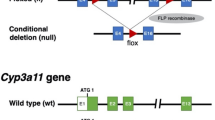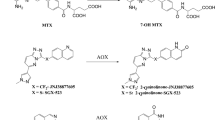Abstract
The clinical development of a candidate p38 kinase inhibitor was terminated because of its unexpectedly rapid clearance in human subjects. Its short half-life and metabolic profile in human beings were vastly different from that in rats, dogs, and monkeys characterized during routine pre-clinical studies. Mice generated the predominant drug (4-hydroxylated) metabolite produced in human beings, which was not found in other species. The data from a murine in vitro drug biotransformation assay that used liver extracts from 14 inbred mouse strains were analyzed by haplotype-based computational genetic analysis. This led to the identification of aldehyde oxidase-1 (AOX1) as the enzyme responsible for the rapid metabolism of this drug. Specific enzyme inhibitors and expressed recombinant enzymes were used to confirm that AOX catalyzed the formation of the 4-hydroxylated drug metabolite in mouse and man. Genetic variation within Aox1 regulated the level of hepatic Aox1 mRNA, AOX1 protein, and enzyme activity among the inbred strains. Thus, computational murine pharmacogenetic analysis can facilitate the identification and characterization of drug metabolism pathways that are differentially utilized by humans and other species.
This is a preview of subscription content, access via your institution
Access options
Subscribe to this journal
Receive 6 print issues and online access
$259.00 per year
only $43.17 per issue
Buy this article
- Purchase on Springer Link
- Instant access to full article PDF
Prices may be subject to local taxes which are calculated during checkout







Similar content being viewed by others
References
Singh SS . Preclinical pharmacokinetics: an approach towards safer and efficacious drugs. Curr Drug Metab 2006; 7: 165–182.
Poggesi I . Predicting human pharmacokinetics from preclinical data. Curr Opin Drug DiscovDevel 2004; 7: 100–111.
Nelson DR, Zeldin DC, Hoffman SM, Maltais LJ, Wain HM, Nebert DW . Comparison of cytochrome P450 (CYP) genes from the mouse and human genomes, including nomenclature recommendations for genes, pseudogenes and alternative-splice variants. Pharmacogenetics 2004; 14: 1–18.
Martignoni M, Groothuis GM, de Kanter R . Species differences between mouse, rat, dog, monkey and human CYP-mediated drug metabolism, inhibition and induction. Expert Opin Drug Metab Toxicol 2006; 2: 875–894.
Lin JH . Species similarities and differences in pharmacokinetics. Drug Metab Dispos 1995; 23: 1008–1021.
Casley WL, Menzies JA, Girard M, Larocque L, Mousseau N, Whitehouse LW et al. Differences in caffeine 3-demethylation activity among inbred mouse strains: a comparison of hepatic Cyp1a2 gene expression between two inbred strains. Fundam Appl Toxicol 1997; 40: 228–237.
Bernard-Helary K, Ardourel MY, Hevor T, Cloix JF . In vivo and in vitro glycogenic effects of methionine sulfoximine are different in two inbred strains of mice. Brain Res 2002; 929: 147–155.
Koster AS, Nieuwenhuis L, Frankhuijzen-Sierevogel AC . Comparison of microsomal drug-metabolizing enzymes in 14 rat inbred strains. Biochem Pharmacol 1989; 38: 759–765.
Guo YY, Weller PF, Farrell E, Cheung P, Fitch B, Clark D et al. In silico pharmacogenetics: warfarin metabolism. Nat Biotechnol 2006; 24: 531–536.
Guo YY, Liu P, Zhang X, Weller PMM, Wang J, Liao G et al. In vitro and in silico pharmacogenetic analysis in mice. Proc Natl Acad Sci USA 2007; 104: 17735–17740.
Liao G, Wang J, Guo J, Allard J, Cheng J, Ng A et al. In silico genetics: identification of a functional element regulating H2-Ea gene expression. Science 2004; 306: 690–695.
Wang J, Liao G, Usuka J, Peltz G . Computational genetics: from mouse to man? Trends Genet 2005; 21: 526–532.
Wang J, Peltz G . Haplotype-Based Computational Genetic Analysis in Mice. Computational Genetics and Genomics: New Tools for Understanding Disease. Humana Press Inc.: Totowa, New Jersey, 2005. pp 51–70.
Wang J, Liao G, Chang J, Nguyen A, Guo J, Chou S et al. Haplotypic Structure of the Mouse Genome. Computational Genetics and Genomics: New Tools for Understanding Disease. Humana Press Inc.: Totowa, New Jersey, 2005. pp 71–83.
Liao G, Zhang X, Clark DJ, Peltz G . A genomic ″roadmap″ to ″better″ drugs. Drug Metab Rev 2008; 40: 225–239.
Boxenbaum H, Ronfeld R . Interspecies pharmacokinetic scaling and the Dedrick plots. Am J Physiol 1983; 245: R768–R775.
Dedrick RL . Animal scale-up. J Pharmacokinet Biopharmacol 1973; 1: 435–461.
Dedrick R, Bischoff KB, Zaharko DS . Interspecies correlation of plasma concentration history of methotrexate (NSC-740). Cancer Chemother Rep 1970; 54: 95–101.
Boxenbaum H . Interspecies pharmacokinetic scaling and the evolutionary-comparative paradigm. Drug Metab Rev 1984; 15: 1071–1121.
Kurosaki M, Demontis S, Barzago MM, Garattini E, Terao M . Molecular cloning of the cDNA coding for mouse aldehyde oxidase: tissue distribution and regulation in vivo by testosterone. Biochem J 1999; 341 (Part 1): 71–80.
Zheng M, Shafer SS, Liao G, Liu H-H, Peltz G . Computational genetic mapping in mice: ‘The Ship has Sailed’. Sci Transl Med 2009; 1: 3ps4.
Capello S, Henderson L, DeGrazia F, Liberato D, Garland W, Town C . The effect of the cytochrome P-450 suicide inactivator, 1-aminobenzotriazole, on the in vivo metabolism and pharmacologic activity of flurazepam. Drug Metab Dispos 1990; 18: 190–196.
Mathews JM, Dostal LA, Bend JR . Inactivation of rabbit pulmonary cytochrome P-450 in microsomes and isolated perfused lungs by the suicide substrate 1-aminobenzotriazole. J Pharmacol Exp Ther 1985; 235: 186–190.
Panoutsopoulos GI, Beedham C . Enzymatic oxidation of vanillin, isovanillin and protocatechuic aldehyde with freshly prepared Guinea pig liver slices. Cell Physiol Biochem 2005; 15: 89–98.
Klaassen CD . Casarett & Doull's Toxicology: The Basic Science of Poisons. 6th edn. The McGraw-Hill Companies, Inc.: Columbus, OH, 2001.
Sugihara K, Kitamura S, Tatsumi K . Involvement of mammalian liver cytosols and aldehyde oxidase in reductive metabolism of zonisamide. Drug MetabDispos 1996; 24: 199–202.
Kawashima K, Hosoi K, Naruke T, Shiba T, Kitamura M, Watabe T . Aldehyde oxidase-dependent marked species difference in hepatic metabolism of the sedative-hypnotic, zaleplon, between monkeys and rats. Drug Metab Dispos 1999; 27: 422–428.
Beedham C, Miceli JJ, Obach RS . Ziprasidone metabolism, aldehyde oxidase, and clinical implications. J Clin Psychopharmacol 2003; 23: 229–232.
Clarke SE, Harrell AW, Chenery RJ . Role of aldehyde oxidase in the in vitro conversion of famciclovir to penciclovir in human liver. Drug Metab Dispos 1995; 23: 251–254.
Rashidi MR, Smith JA, Clarke SE, Beedham C . In vitro oxidation of famciclovir and 6-deoxypenciclovir by aldehyde oxidase from human, guinea pig, rabbit, and rat liver. Drug Metab Dispos 1997; 25: 805–813.
Beedham C . Molybdenum hydroxylases as drug-metabolizing enzymes. Drug Metab Rev 1985; 16: 119–156.
Gluecksohn-Waelsch S, Greengard P, Quinn GP, Teicher LS . Genetic variations of an oxidase in mammals. J Biol Chem 1967; 242: 1271–1273.
Kitamura S, Sugihara K, Ohta S . Drug-metabolizing ability of molybdenum hydroxylases. Drug Metab Pharmacokinet 2006; 21: 83–98.
Itoh K, Maruyama H, Adachi M, Hoshino K, Watanabe N, Tanaka Y . Lack of dimer formation ability in rat strains with low aldehyde oxidase activity. Xenobiotica 2007; 37: 709–716.
Itoh K, Maruyama H, Adachi M, Hoshino K, Watanabe N, Tanaka Y . Lack of formation of aldehyde oxidase dimer possibly due to 377G>A nucleotide substitution. Drug Metab Dispos 2007; 35: 1860–1864.
Adachi M, Itoh K, Masubuchi A, Watanabe N, Tanaka Y . Construction and expression of mutant cDNAs responsible for genetic polymorphism in aldehyde oxidase in Donryu strain rats. J Biochem Mol Biol 2007; 40: 1021–1027.
Smith MA, Marinaki AM, Arenas M, Shobowale-Bakre M, Lewis CM, Ansari A et al. Novel pharmacogenetic markers for treatment outcome in azathioprine-treated inflammatory bowel disease. Aliment Pharmacol Ther 2009; 30: 375–384.
Wright RM, Clayton DA, Riley MG, McManaman JL, Repine JE . cDNA cloning, sequencing, and characterization of male and female rat liver aldehyde oxidase (rAOX1). Differences in redox status may distinguish male and female forms of hepatic APX. J Biol Chem 1999; 274: 3878–3886.
Rettie AE, Fisher MB . Transformation enzymes: oxidative; non-P450. In: Woolf TF (ed). Handbook of Drug Metabolism. Marcel Dekker: New York, New York, 1999. pp 131–151.
Acknowledgements
This work was partially supported by grant 756 GM068885-05 from the NIGMS awarded to GP. We thank Michael Soth and Adrian Fretland for valuable discussions and Zhaomei Zhang, Hoangdung Ho, Erin Farrell, Wendy Klopf, and Olga Vilenski for reviewing the manuscript.
Author information
Authors and Affiliations
Corresponding author
Ethics declarations
Competing interests
The manuscript has not been published elsewhere, nor is it being evaluated for publication elsewhere. Several authors are employees of Roche Palo Alto, but there are no other conflicts of interest around this manuscript.
Additional information
Supplementary Information accompanies the paper on the The Pharmacogenomics Journal website
Rights and permissions
About this article
Cite this article
Zhang, X., Liu, HH., Weller, P. et al. In silico and in vitro pharmacogenetics: aldehyde oxidase rapidly metabolizes a p38 kinase inhibitor. Pharmacogenomics J 11, 15–24 (2011). https://doi.org/10.1038/tpj.2010.8
Received:
Revised:
Accepted:
Published:
Issue Date:
DOI: https://doi.org/10.1038/tpj.2010.8
Keywords
This article is cited by
-
Roles of selected non-P450 human oxidoreductase enzymes in protective and toxic effects of chemicals: review and compilation of reactions
Archives of Toxicology (2022)
-
Predicting liver cytosol stability of small molecules
Journal of Cheminformatics (2020)
-
In Vitro Metabolism by Aldehyde Oxidase Leads to Poor Pharmacokinetic Profile in Rats for c-Met Inhibitor MET401
European Journal of Drug Metabolism and Pharmacokinetics (2019)
-
Xenobiotica-metabolizing enzymes in the skin of rat, mouse, pig, guinea pig, man, and in human skin models
Archives of Toxicology (2018)
-
Identification of cryptolepine metabolites in rat and human hepatocytes and metabolism and pharmacokinetics of cryptolepine in Sprague Dawley rats
BMC Pharmacology and Toxicology (2017)



